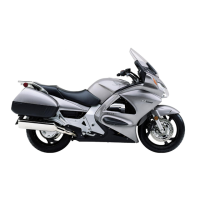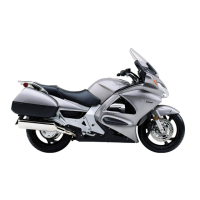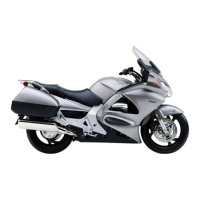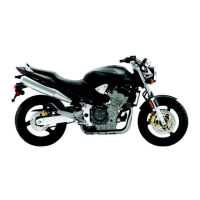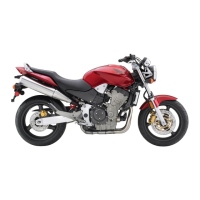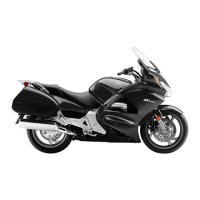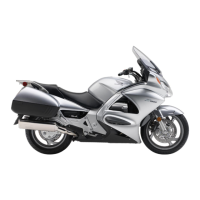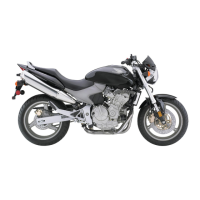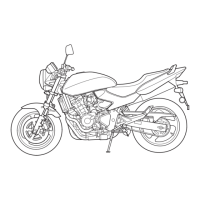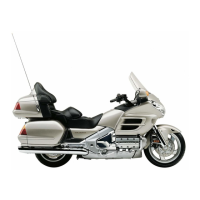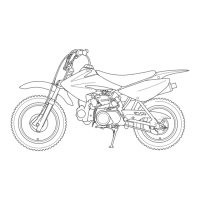Do you have a question about the Honda 2003 CB900F and is the answer not in the manual?
Tips to make yourself more visible to other drivers and signal intentions clearly.
Advisories on riding limits, including effects of alcohol, drugs, fatigue, and speed.
Recommendations for essential riding gear, including helmets, eye protection, and clothing.
Guidance on selecting and wearing helmets and eye protection for maximum safety.
Advisories against modifying the motorcycle, which can affect safety and legality.
Description of various indicator lights such as neutral, high beam, oil pressure, and PGM-FI.
Instructions on adjusting the rear shock spring preload for different load conditions.
Procedures for checking front and rear brake fluid levels and lever adjustments.
Steps to adjust the clutch lever free play and cable for smooth engagement.
Procedures for checking engine oil level and selecting appropriate oil quality and viscosity.
Explanation of the HISS indicator light and instructions for operating the immobilizer system.
Essential checks to perform before each ride for safety and proper function.
Detailed steps for starting the motorcycle's engine, including procedures for different conditions.
Instructions on proper riding techniques, gear shifting, and throttle control.
Proper braking techniques, including smooth deceleration and use of front and rear brakes.
Safety warnings and precautions to follow when performing maintenance tasks.
Key safety precautions for performing motorcycle maintenance, including hazard awareness.
Schedule outlining required maintenance tasks at specified intervals or odometer readings.
Guide to selecting the correct engine oil viscosity based on ambient temperature.
Information on recommended spark plugs and precautions for their installation.
Instructions for cleaning or replacing the air cleaner element.
How to check and adjust the drive chain slack and inspect for wear.
Procedures for removing and reinstalling the front and rear wheels.
How to inspect front and rear brake pads for wear using indicator grooves or cutouts.
Tips to make yourself more visible to other drivers and signal intentions clearly.
Advisories on riding limits, including effects of alcohol, drugs, fatigue, and speed.
Recommendations for essential riding gear, including helmets, eye protection, and clothing.
Guidance on selecting and wearing helmets and eye protection for maximum safety.
Advisories against modifying the motorcycle, which can affect safety and legality.
Description of various indicator lights such as neutral, high beam, oil pressure, and PGM-FI.
Instructions on adjusting the rear shock spring preload for different load conditions.
Procedures for checking front and rear brake fluid levels and lever adjustments.
Steps to adjust the clutch lever free play and cable for smooth engagement.
Procedures for checking engine oil level and selecting appropriate oil quality and viscosity.
Explanation of the HISS indicator light and instructions for operating the immobilizer system.
Essential checks to perform before each ride for safety and proper function.
Detailed steps for starting the motorcycle's engine, including procedures for different conditions.
Instructions on proper riding techniques, gear shifting, and throttle control.
Proper braking techniques, including smooth deceleration and use of front and rear brakes.
Safety warnings and precautions to follow when performing maintenance tasks.
Key safety precautions for performing motorcycle maintenance, including hazard awareness.
Schedule outlining required maintenance tasks at specified intervals or odometer readings.
Guide to selecting the correct engine oil viscosity based on ambient temperature.
Information on recommended spark plugs and precautions for their installation.
Instructions for cleaning or replacing the air cleaner element.
How to check and adjust the drive chain slack and inspect for wear.
Procedures for removing and reinstalling the front and rear wheels.
How to inspect front and rear brake pads for wear using indicator grooves or cutouts.
| Displacement | 919 cc |
|---|---|
| Compression Ratio | 10.8:1 |
| Ignition | Computer-controlled digital transistorized with electronic advance |
| Transmission | 6-speed |
| Final Drive | O-ring-sealed chain |
| Rear Brakes | Single 240mm disc with single-piston caliper |
| Fuel Capacity | 5.0 gallons |
| Curb Weight | 485 pounds |
| Rake (Caster Angle) | 25.0 degrees |
| Bore x Stroke | 71.0mm x 58.0mm |
| Fuel System | PGM-FI fuel injection |
| Induction | Electronic fuel injection |
| Front Suspension | 43mm HMAS cartridge-type fork |
| Rear Suspension | Single HMAS shock with seven-position spring preload adjustability |
| Front Brakes | Dual 296mm discs with 4-piston calipers |
| Front Tire | 120/70ZR-17 |
| Rear Tire | 180/55ZR-17 |
| Engine Type | Inline four-cylinder, DOHC |
| Trail | 98mm (3.9 inches) |

